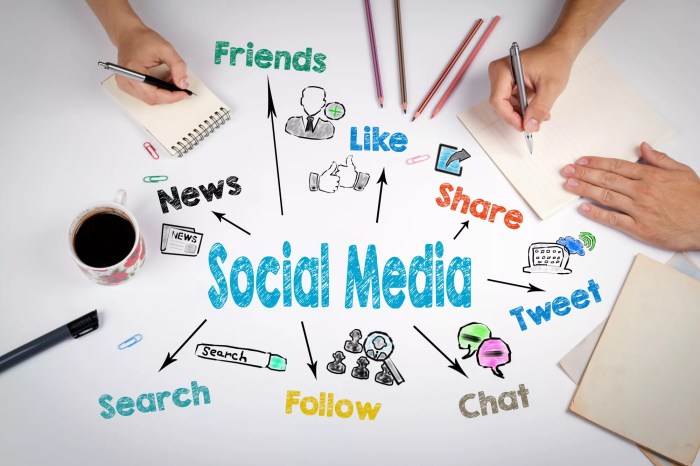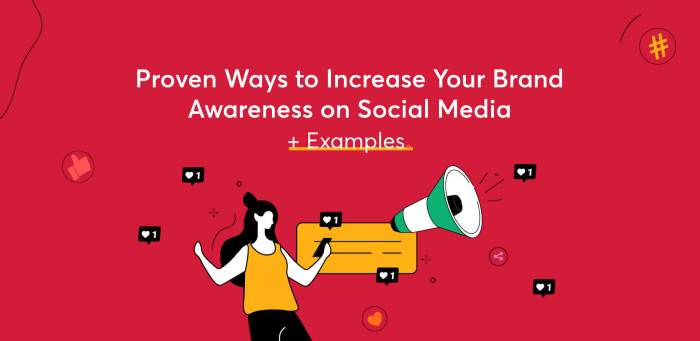Using Social Media for Brand Awareness sets the stage for boosting your brand’s visibility in the digital realm. Get ready to dive into a world where hashtags, influencers, and compelling content reign supreme.
Explore the power of social media in creating lasting impressions and connecting with your target audience like never before.
Importance of Social Media for Brand Awareness

Social media plays a crucial role in building brand awareness in today’s digital age. With billions of users across various platforms, social media provides a vast and accessible space for brands to showcase their products or services to a global audience.
Reaching a Larger Audience
- Social media platforms such as Facebook, Instagram, and Twitter allow brands to reach a larger audience than traditional marketing channels.
- Through targeted advertising and engaging content, brands can connect with specific demographics and interests, expanding their reach exponentially.
- By utilizing features like hashtags and sharing tools, brands can encourage users to spread their message organically, reaching an even wider audience.
Successful Brand Awareness Campaigns
- One successful example is the #ShareACoke campaign by Coca-Cola, where personalized bottles with individual names were created, encouraging customers to share their unique bottles on social media platforms.
- The ALS Ice Bucket Challenge is another notable campaign that went viral on social media, raising awareness and funds for amyotrophic lateral sclerosis (ALS).
- Dove’s Real Beauty campaign focused on body positivity and self-acceptance, resonating with audiences and generating widespread discussion on social media platforms.
Strategies for Using Social Media for Brand Awareness
In today’s digital age, social media has become a powerful tool for businesses to increase brand awareness and reach a larger audience. Implementing the right strategies can make a significant impact on how your brand is perceived and recognized online.
Influencer Partnerships
Collaborating with influencers who have a strong following and influence in your industry can help you reach a wider audience. By partnering with influencers who align with your brand values, you can leverage their credibility and reach to promote your products or services effectively.
User-Generated Content
Encouraging your audience to create and share content related to your brand can help build trust and credibility. User-generated content not only showcases real experiences with your brand but also increases engagement and loyalty among your followers.
Contests
Hosting contests or giveaways on social media can generate excitement and increase brand visibility. By offering prizes or incentives, you can encourage user participation and create buzz around your brand. Contests are a great way to attract new followers and keep existing ones engaged.
Engaging Content
Creating compelling and relevant content is key to increasing brand visibility on social media. Whether it’s informative blog posts, captivating images, or entertaining videos, engaging content can capture the attention of your audience and encourage them to share and interact with your brand.
Hashtags and Trends
Utilizing popular hashtags and staying up-to-date with current trends can help amplify your brand messages and reach a broader audience. By incorporating relevant hashtags in your posts and participating in trending conversations, you can increase the visibility of your brand and attract new followers.
Choosing the Right Social Media Platforms
When it comes to choosing the right social media platforms for brand awareness, it’s essential to consider where your target audience spends their time online. Each platform has its unique features and demographics that can impact the effectiveness of your brand awareness strategies.
Facebook, Using Social Media for Brand Awareness
- Facebook is one of the most popular social media platforms with a diverse user base, making it suitable for reaching a wide range of audiences.
- It offers robust advertising options, including targeted ads based on user demographics, interests, and behavior.
- Businesses can create engaging content through posts, videos, and live streams to connect with their audience.
- Instagram is highly visual, making it ideal for brands that rely on imagery to showcase their products or services.
- The platform is popular among younger demographics, particularly millennials and Gen Z, making it effective for brands targeting a younger audience.
- Instagram Stories and IGTV provide additional opportunities for brands to engage with their audience in a more authentic and interactive way.
- Twitter is known for its real-time updates and quick interactions, making it suitable for brands looking to stay current and engage in conversations around trending topics.
- The platform is great for sharing bite-sized content, such as tweets and links, to drive traffic to your website or other social media channels.
- Twitter chats and hashtags can help increase brand visibility and reach a wider audience beyond your followers.
- LinkedIn is a professional networking platform, making it ideal for B2B brands or those targeting a professional audience.
- It offers features like LinkedIn Pulse for publishing articles and thought leadership content to establish your brand as an industry leader.
- LinkedIn Ads allow for precise targeting based on job title, industry, company size, and more, making it effective for reaching decision-makers.
Utilizing multiple platforms can provide a comprehensive brand awareness strategy by allowing you to reach different audience segments and engage with them in ways that resonate with each platform’s unique features. By selecting the most suitable platforms based on your target audience and brand objectives, you can maximize your brand’s visibility and impact in the digital landscape.
Measuring Success and ROI: Using Social Media For Brand Awareness

In evaluating brand awareness campaigns on social media, it is crucial to track key metrics such as reach, engagement, and conversions to measure success and return on investment.
Key Metrics for Evaluation
- Reach: This metric measures the total number of people who have seen your brand’s content on social media. It helps in understanding the awareness level of your brand among the audience.
- Engagement: Engagement metrics include likes, comments, shares, and clicks on your posts. It indicates how well your content resonates with your audience and helps in building brand loyalty.
- Conversions: Tracking conversions such as sign-ups, purchases, or other desired actions resulting from your social media efforts is essential to determine the impact on your bottom line.
Tools and Methods for Tracking Performance
- Analytics Tools: Platforms like Facebook Insights, Twitter Analytics, and Google Analytics provide detailed data on reach, engagement, and conversions. Utilize these tools to track and analyze your social media performance.
- URL Parameters: Using UTM parameters in your social media links allows you to track the source of traffic and measure the effectiveness of your campaigns in driving conversions.
- Social Listening: Monitor social media conversations about your brand using tools like Mention or Hootsuite to gauge brand sentiment and identify areas for improvement.
Analyzing Data for Optimization
- Identify Top Performing Content: Analyze which posts have the highest reach, engagement, and conversions to understand what resonates with your audience and replicate successful strategies.
- A/B Testing: Experiment with different content formats, messaging, and visuals to determine what drives the best results and optimize future campaigns based on data-driven insights.
- Adjust Strategies: Use the data collected to refine your social media strategy, allocate resources effectively, and make informed decisions to enhance brand awareness and ROI.
